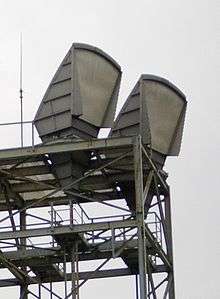C band (IEEE)
Frequency range | 4 – 8 GHz |
|---|---|
Wavelength range | 7.5 – 3.75 cm |
Related bands |
| ITU radio bands | ||||||||||||
|---|---|---|---|---|---|---|---|---|---|---|---|---|
|
||||||||||||
| EU / NATO / US ECM radio bands | ||||||||||||
| IEEE radio bands | ||||||||||||
| Other TV and radio bands | ||||||||||||

The C-band is a designation by the Institute of Electrical and Electronics Engineers (IEEE) for a portion of the electromagnetic spectrum in the microwave range of frequencies ranging from 4.0 to 8.0 gigahertz (GHz);[1] however, this definition is the one used by radar manufacturers and users, not necessarily by microwave radio telecommunications users. The C-band (4 to 8 GHz) is used for many satellite communications transmissions, some Wi-Fi devices, some cordless telephones, and some weather radar systems.
The communications C-band was the first frequency band that was allocated for commercial telecommunications via satellites. The same frequencies were already in use for terrestrial microwave radio relay chains. Nearly all C-band communication satellites use the band of frequencies from 3.7 to 4.2 GHz for their downlinks, and the band of frequencies from 5.925 to 6.425 GHz for their uplinks. Note that by using the band from 3.7 to 4.0 GHz, this C-band overlaps somewhat into the IEEE S-band for radars.
The C-band communication satellites typically have 24 radio transponders spaced 20 MHz apart, but with the adjacent transponders on opposite polarizations.[2] Hence, the transponders on the same polarization are always 40 MHz apart. Of this 40 MHz, each transponder utilizes about 36 MHz. (The unused 4.0 MHz between the pairs of transponders acts as "guard bands" for the likely case of imperfections in the microwave electronics.)
One use of the C-band is for satellite communication, whether for full-time satellite television networks or raw satellite feeds, although subscription programming also exists. This use contrasts with direct-broadcast satellite, which is a completely closed system used to deliver subscription programming to small satellite dishes that are connected with proprietary receiving equipment.
The satellite communications portion of the C-band is highly associated with television receive-only satellite reception systems, commonly called "big dish" systems, since small receiving antennas are not optimal for C-band systems. Typical antenna sizes on C-band capable systems ranges from 7.5 to 12 feet (2.5 to 3.5 meters) on consumer satellite dishes, although larger ones also can be used. For satellite communications, the microwave frequencies of the C-band perform better under adverse weather conditions in comparison with the Ku band (11.2 GHz to 14.5 GHz), microwave frequencies used by other communication satellites.[3] Rain fade – the collective name for the negative effects of adverse weather conditions on transmission – is mostly a consequence of precipitation and moisture in the air.
The C-band also includes the 5.8 GHz ISM band between 5.725 - 5.875 GHz, which is used for medical and industrial heating applications and many unlicensed short range microwave communication systems, such as cordless phones, baby monitors, and keyless entry systems for vehicles. The C-band frequencies of 5.4 GHz band [5.15 to 5.35 GHz, 5.47 to 5.725 GHz, or 5.725 to 5.875 GHz, depending on the region of the world] are used for IEEE 802.11a Wi-Fi wireless computer networks.
Differences in frequency range by geographic area
Slight variations in the assignments of C-band frequencies have been approved for use in various parts of the world, depending on their locations in the three ITU radio regions. Note that one region includes all of Europe and Africa, plus all of Russia; a second includes all of the Americas, and the third region includes all of Asia outside of Russia, plus Australia and New Zealand. This latter region is the most populous one, since it includes the People's Republic of China, India, Pakistan, Japan, and Southeast Asia.
| C-Band Variations Around The World | ||
| Band | Transmit Frequency (GHz) |
Receive Frequency (GHz) |
| Standard C-Band | 5.850–6.425 | 3.625–4.200 |
| Super Extended C-Band | 6.425–6.725 | 3.400–3.625 |
| INSAT | 6.725–7.025 | 4.500–4.800 |
| Russian C-Band | 5.975–6.475 | 3.650–4.150 |
| LMI C-Band | 5.7250–6.025 | 3.700–4.000 |
Amateur radio
The Radio Regulations of the International Telecommunication Union allow amateur radio operations in the frequency range 5.650 to 5.925 GHz, and amateur satellite operations are allowed in the ranges 5.830 to 5.850 GHz for down-links and 5.650 to 5.670 GHz for up-links. This is known as the 5-centimeter band by amateurs and the C-band by AMSAT.
Particle accelerators
Particle accelerators may be powered by C-band RF sources. The frequencies are then standardized at 5.996 GHz (Europe) or 5.712 GHz (US),[4] which is the second harmonic of S-band.
References
- ↑ Peebles, Peyton Z., Jr, (1998), Radar Principles, John Wiley and Sons, Inc., p 20
- ↑ "North & South America - LyngSat". www.lyngsat.com. Archived from the original on 30 September 2017. Retrieved 30 April 2018.
- ↑ What is C Band Archived 2007-04-30 at the Wayback Machine. page from tech-faq (accessed Aug. 14, 2008)
- ↑ "Archived copy" (PDF). Archived (PDF) from the original on 2016-09-17. Retrieved 2016-10-11.
